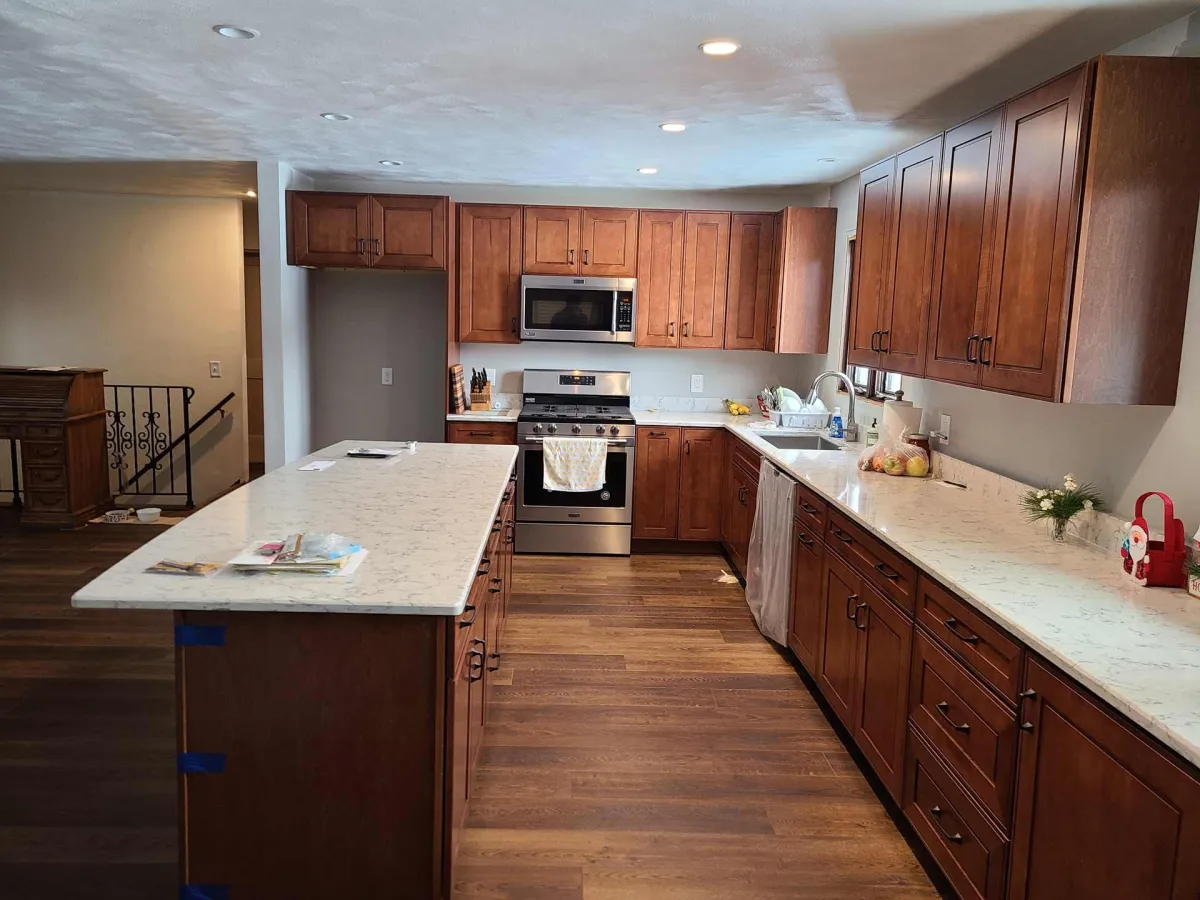Quad Cities
Flooring Installation Services in Quad Cities
Flooring Installation
Is It Time to Replace Your Flooring?
If you notice any of the following signs, it may be time to replace your flooring:
Cracks or chips in tiles or hardwood planks, indicating significant wear and damage.
Persistent stains that cannot be removed, detracting from the appearance of your floors.
Warping or buckling in wood flooring caused by moisture damage.
Loose or squeaky floorboards that indicate structural issues.
Fading or discoloration from sunlight exposure, making your floors look old and worn.
Outdated styles that no longer match your home’s decor.
Noticeable wear patterns in high-traffic areas, especially in carpets.

Types of Flooring We Install
We offer a variety of flooring options to suit your needs and preferences. Here are the types of flooring we install:
Hardwood Flooring
Hardwood flooring provides a timeless and elegant look. It is durable, easy to clean, and available in various wood species, colors, and finishes.
Laminate Flooring
Laminate flooring is a cost-effective alternative to hardwood. It mimics the appearance of wood or stone and is resistant to scratches, stains, and wear.
Tile Flooring
Tile flooring is versatile and available in a wide range of materials, including ceramic, porcelain, and natural stone. It is perfect for areas prone to moisture, such as bathrooms and kitchens.
Vinyl Flooring
Vinyl flooring is known for its durability and water resistance. It comes in various styles, including planks, tiles, and sheets, offering a versatile and affordable flooring solution.
Carpet Flooring
Carpet flooring provides comfort and warmth, making it ideal for bedrooms and living areas. It is available in numerous textures, colors, and patterns to match any decor.
Solving Common Flooring Installation Problems
Flooring installation can come with various challenges. Here are some common problems and how we address them:
Uneven Subfloors: We level the subfloor before installation to ensure a smooth and stable surface for your new flooring.
Moisture Issues: We test for moisture levels and use moisture barriers if necessary to prevent damage to your flooring.
Incorrect Measurements: Accurate measurements are crucial. We double-check all measurements to avoid any gaps or overlaps.
Poor Adhesion: We use high-quality adhesives and ensure proper application techniques to prevent tiles or planks from loosening.
Gaps Between Planks or Tiles: We ensure precise cutting and fitting to eliminate gaps and create a seamless look.
Mismatched Patterns: For patterned flooring, we meticulously align the design to ensure a cohesive and visually appealing result.
Factors to Consider Before Installing New Floors
Before installing new floors, consider the following factors to ensure a successful project:
Room Usage: Determine the primary use of the room. High-traffic areas require durable flooring, while comfort may be a priority in bedrooms.
Moisture Levels: Assess the moisture levels in the room. Areas like bathrooms and basements need moisture-resistant flooring options.
Subfloor Condition: Check the condition of your subfloor. It should be level, clean, and dry to support the new flooring properly.
Style and Aesthetics: Choose flooring that complements your home’s decor and style. Consider color, texture, and material to achieve the desired look.
Maintenance Requirements: Evaluate how much time you can dedicate to floor maintenance. Some materials, like hardwood, require more upkeep than others, like vinyl.
Budget: Determine your budget for the project. Factor in the cost of materials, installation, and any additional preparation work needed.
Frequently Asked Questions
What should I do to prepare my home for flooring installation?
To prepare your home for flooring installation, clear the room of all furniture and personal items. Ensure the subfloor is clean and in good condition. Make arrangements to keep pets and children out of the work area for safety.
How long does it typically take to install new flooring?
The time required to install new flooring depends on the type and size of the project. For example, hardwood flooring can take several days to install and finish, while laminate or vinyl flooring might only take one to two days.
Do I need to remove my old flooring before installation?
In most cases, removing old flooring is necessary to ensure a proper installation. However, some types of flooring, like certain vinyl or laminate options, can be installed over existing floors if they are in good condition and level.
What type of flooring is best for high-moisture areas?
For high-moisture areas like bathrooms and basements, consider materials such as ceramic tile, porcelain tile, or waterproof vinyl. These materials are resistant to water and humidity, reducing the risk of damage.
How do I choose the right underlayment for my new flooring?
The right underlayment depends on the type of flooring being installed and the subfloor condition. For instance, laminate flooring typically requires a foam underlayment for cushioning and moisture protection, while tile may require a cement backer board for stability.
Can I install new flooring over radiant heating systems?
Yes, many flooring types can be installed over radiant heating systems, including tile, engineered wood, and certain types of vinyl and laminate. It’s important to choose flooring materials that are compatible with radiant heat and to follow manufacturer guidelines for installation.
CONTACT US
Contact Fowler Construction for Expert Flooring Installation
Ready to upgrade your floors? Contact Fowler Construction for professional flooring installation services. Call us at (309) 582-6538 or visit our website at fowlerconstructionil.com to get started today.
Our Services
Contact Information
Call (309) 582-6538
Address: Quad Cities
Business Hours:
Mon - Fri : 7:00AM - 5:00PM
Sat : 8:00AM - 12:00PM
Our LOCATION
© 2024 All Rights Reserved | Fowler Construction
